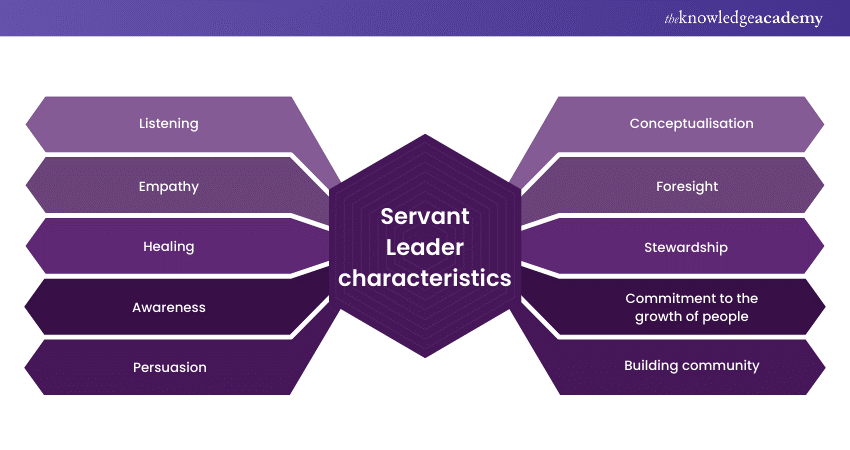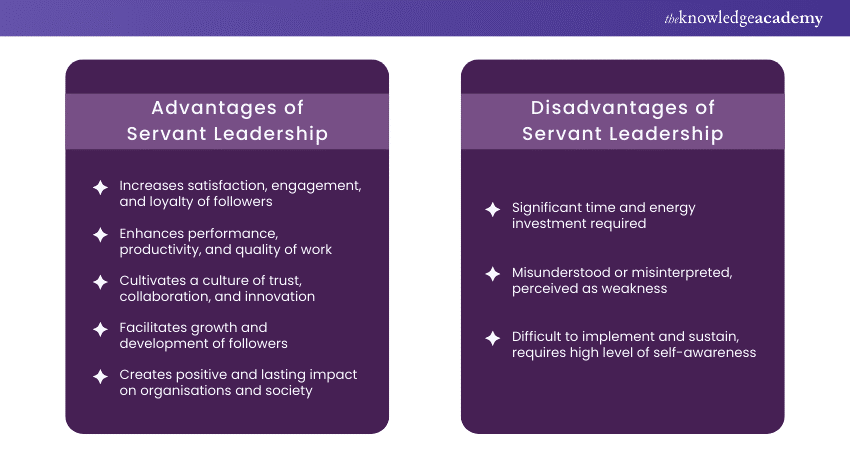We may not have the course you’re looking for. If you enquire or give us a call on 01344203999 and speak to our training experts, we may still be able to help with your training requirements.
Training Outcomes Within Your Budget!
We ensure quality, budget-alignment, and timely delivery by our expert instructors.

Servant Leadership is a Leadership approach that emphasises the well-being and growth of the people and communities they serve. It is based on the idea that Leaders should be servants first and Leaders second. Servant Leaders put the needs of others before their own and seek to create a positive impact through their actions.
But what does Servant Leadership look like in practice? How can you become a Servant Leader yourself? What are the advantages and disadvantages of this approach? In this blog, we will delve into these questions and beyond, comprehensively exploring all aspects of Servant Leadership.
Table of Contents
1) What is Servant Leadership?
2) The Functions of Servant Leadership
3) Servant Leader Characteristics
4) What does the practical application of Servant Leadership entail?
5) The benefits and drawbacks of Servant Leadership
6) Servant Leadership Example
7) Conclusion
What is Servant Leadership?
Servant Leadership is a concept that Robert K. Greenleaf introduced in his 1970 essay, “The Servant as Leader”. He explained it like this:
“The servant-Leader puts serving others first… It starts with the natural desire to help, to help first. Then, deliberate choice makes one aspire to lead. This person is very different from one who is a Leader first, maybe because of the need to satisfy an unusual urge for power or to obtain material wealth. The servant-first and the Leader-first are two opposite types. Between them, there are variations and combinations that are part of the endless diversity of human nature.”
In other words, Servant Leadership is not about being a Leader who serves but rather a servant who leads. It is a philosophy that challenges the traditional notion of Leadership as a position of authority and instead views it as a responsibility to serve.
The functions of Servant Leadership
The main role of a Servant Leader is to assist others in their journey towards improved health, wisdom, autonomy, and freedom. Additionally, a Servant Leader aims to cultivate a culture where individuals are empowered to serve others, fostering a cycle of Servant Leadership within the community or organisation.
Servant Leader characteristics
Here is the list of characteristics needed to be a successful Servant Leader:

a) Listening
A Servant Leader listens attentively and empathetically to the needs, concerns, and opinions of others without imposing their own agenda or judgment.
b) Empathy
A Servant Leader strives to understand and accept others for who they are and values their unique perspectives and contributions.
c) Healing
A Servant Leader recognises the emotional and psychological wounds that people may carry and seeks to promote healing and wholeness through their words and actions.
d) Awareness
A Servant Leader possesses self-awareness regarding their strengths, weaknesses, values, and emotions, understanding how these factors influence their interactions with others. They are also aware of the social and environmental contexts in which they operate and the impact they have on them.
e) Persuasion
A Servant Leader does not rely on coercion or manipulation to influence others but rather uses gentle and rational arguments to convince them of a shared vision or goal.
f) Conceptualisation
A Servant Leader can think beyond the day-to-day realities and problems and envision the bigger picture and the long-term outcomes. They can balance the immediate and the future and align their actions with their vision.
g) Foresight
A Servant Leader can anticipate the likely consequences of their decisions and actions and the potential opportunities and challenges that may arise. They can use their intuition and experience to guide their choices and actions.
h) Stewardship
A Servant Leader acts as a steward of the resources and the people that they are entrusted with. They are accountable for their actions and their impact, and they use their power and authority responsibly and ethically.
i) Commitment to the growth of people
A Servant Leader dedicates themselves to fostering the personal and professional growth and development of those under their care. They provide them with opportunities to learn, grow, and excel, and they support them in achieving their goals and potential.
j) Building community
A Servant Leader fosters a sense of community and belonging among the people they serve. They encourage collaboration, cooperation, and mutual respect, and they create a culture of trust and care.
Unlock your Leadership potential and elevate your career with our comprehensive Leadership Courses.
What does the practical application of Servant Leadership entail?
Servant Leadership is not a one-size-fits-all approach but rather a flexible and adaptable one that can be applied in different contexts and situations. However, some common practices that can help you implement Servant Leadership in your own setting are:
Setting an example with humility, sincerity, and confidence
A Servant Leader leads by example, not by command. They demonstrate the values and behaviours that they expect from others, and they do so with humility, sincerity, and confidence. They admit their mistakes, learn from their failures, and celebrate their successes. They do not seek recognition or praise but rather acknowledge the contributions of others. They do not boast or brag but rather express gratitude and appreciation. They do not act superior or arrogant but rather show respect and dignity.
Outlining the awareness and purpose of the work and why it is necessary
A Servant Leader communicates clearly and effectively the purpose and the goals of the work and why it is important and meaningful. They help others comprehend the significance of their work within the broader context and how it contributes to the collective welfare and common goals. They inspire others with a compelling vision and a shared mission, and they motivate them with passion and enthusiasm.
Promoting teamwork, dedication, and community building
A Servant Leader promotes teamwork, dedication, and community building among the people they serve. They encourage collaboration, cooperation, and mutual support, and they facilitate communication, feedback, and conflict resolution. They delegate tasks and responsibilities appropriately, and they empower others to make decisions and take action. They recognise and reward the efforts and achievements of others, and they celebrate the successes and milestones of the team.
Servant Leaders cultivate a positive and nurturing work environment where individuals feel valued, respected, and acknowledged for their contributions.
Fostering the growth and development of the team via insight and ingenuity
A Servant Leader fosters the growth and development of the team via insight and ingenuity. They provide opportunities for learning, training, and mentoring, and they support the personal and professional development of others. They challenge others to stretch their abilities and skills, and they encourage them to pursue their interests and passions. They stimulate creativity, innovation, and problem-solving, and they welcome new ideas and suggestions. They nurture the talents and potential of others, and they help them achieve their goals and aspirations.
Showing understanding and sympathy for fellow team members
A Servant Leader shows understanding and sympathy for fellow team members. They care about the well-being and happiness of others, and they show compassion and empathy for their needs, feelings, and challenges. They listen attentively and empathetically to others, and they offer support, guidance, and advice. They are approachable and accessible, and they make time for others. They are friendly and courteous, and they show kindness and generosity.
Asking for feedback — listening skills
A Servant Leader asks for feedback — listening skills. They seek input and opinions from others, and they value their perspectives and insights. They listen actively and attentively to others, and they ask open-ended and probing questions. They are open-minded and receptive to constructive criticism and suggestions, and they use them to improve their performance and effectiveness. They acknowledge and appreciate the feedback they receive, and they act on it accordingly.
The benefits and drawbacks of Servant Leadership
Servant Leadership has many benefits, both for the Leaders and the followers, as well as for the organisations and the society. Some of the benefits are:
a) Servant Leadership can increase the satisfaction, engagement, and loyalty of the followers, as they feel respected, valued, and cared for by their Leaders.
b) Servant Leadership can enhance the performance, productivity, and quality of the work, as the followers are motivated, empowered, and committed to their work and their goals.
c) Servant Leadership has the potential to cultivate a culture grounded in trust, collaboration, and innovation. By encouraging followers to share their ideas, opinions, and feedback and fostering a team-oriented approach, Servant Leaders create an environment where collective contributions are valued and creativity thrives.
d) Servant Leadership can facilitate the growth and development of the followers, as the Leaders provide them with opportunities to learn, grow, excel, and achieve their potential.
e) Servant Leadership can create a positive and lasting impact on organisations and society as the Leaders and the followers work towards a common vision and a greater good.
However, Servant Leadership also has some drawbacks or challenges that need to be considered and addressed. Some of the drawbacks are:
a) Servant Leadership entails significant time and energy investment, as Leaders prioritise serving the needs of others while navigating various stakeholder demands and expectations.
b) Servant Leadership can be misunderstood or misinterpreted, as some people may perceive it as a sign of weakness, passivity, or indecisiveness or as a lack of authority, direction, or control.
c) Servant Leadership can be difficult to implement and sustain, as it requires a high level of self-awareness, emotional intelligence, and ethical standards, and it may face resistance or opposition from those who are used to or prefer a different style of Leadership.

Servant Leadership Example
To illustrate how Servant Leadership works in practice, let us look at an example of a well-known Servant Leader.
Winston Churchill served as the Prime Minister of the United Kingdom during the tumultuous period of the Second World War. He was one of the most influential and admired Leaders of the 20th century. He is widely regarded as a hero, statesman, and a symbol of courage, resilience, and eloquence.
Churchill demonstrated the characteristics and practices of a Servant Leader in many ways, such as:
a) He listened to and empathised with the needs and fears of the British people, and he communicated with them regularly and honestly through his speeches and broadcasts. He inspired them with his vision and his confidence, and he rallied them to resist the Nazi threat.
b) He healed the wounds and divisions caused by the previous failures and appeasements of the British government, and he forged a strong and united coalition with the Allies. He also sought to promote peace and reconciliation after the war and advocated for the creation of the United Nations and the European Union.
c) He was aware of his strengths and weaknesses and leveraged his talents and skills to serve his country and his cause. He was also aware of his time's historical and geopolitical context, and he devised his strategies and policies accordingly.
d) He persuaded others to follow his Leadership and to support his decisions rather than imposing his will or authority. He convinced them of the moral and strategic necessity of his actions and the possibility of overcoming the odds and achieving victory.
e) He envisioned a free and democratic world where the people would enjoy their rights and liberties. He also envisioned a lasting partnership between the UK and the US, where they would share their values and interests.
f) He foresaw the consequences of his actions and the challenges that he and his allies would face, and he prepared them for the hardships and dangers they would have to endure. He also anticipated the opportunities and changes his Leadership would bring, and he seized them with courage and optimism.
g) He acted as a steward of the resources and people he was entrusted with, and he used them wisely and responsibly. He was accountable for his actions and their impact and never abused his power or authority. He also sacrificed his health and comfort and led a demanding and stressful life.
h) He was committed to the growth and development of the people he served and provided them with education, training, and guidance. He also encouraged them to develop their Leadership skills and capacities and take charge of their destiny.
i) He built a community of followers and supporters who shared his vision and values and worked together as a team. He fostered a culture of trust and care and treated everyone with kindness. Churchill’s Servant Leadership had a profound and lasting impact on the UK and the world. He led his country and his allies to victory against the Nazi tyranny, and he secured their freedom and democracy.
Enhance your Leadership skills and become a more effective Leader with our specialised Leadership Skills Course. Register Now!
Conclusion
Servant Leadership is characterised by prioritising the needs and well-being of others above the self-interest of the Leader, exemplifying a style of Leadership focused on serving and uplifting others. It is based on the idea that Leaders should be servants first and Leaders second. Servant Leadership can be applied in different contexts and situations, and it has many benefits and drawbacks.
Transform your Leadership approach and drive success in Agile environments with our Agile Leadership Training. Join today!
Frequently Asked Questions

Servant Leadership is a philosophy that prioritises serving others over exercising power or authority. Traditional Leadership is a style that relies on positional power and control to influence others. Servant Leaders focus on empowering and developing their followers, while Traditional Leaders focus on achieving goals and outcomes.

Servant Leadership can create a positive organisational culture that fosters trust, collaboration, and innovation. Employees who work under Servant Leaders tend to be more engaged, motivated, and productive. Servant Leadership can also enhance employee retention, customer satisfaction, and social responsibility.

The Knowledge Academy takes global learning to new heights, offering over 30,000 online courses across 490+ locations in 220 countries. This expansive reach ensures accessibility and convenience for learners worldwide.
Alongside our diverse Online Course Catalogue, encompassing 17 major categories, we go the extra mile by providing a plethora of free educational Online Resources like News updates, Blogs, videos, webinars, and interview questions. Tailoring learning experiences further, professionals can maximise value with customisable Course Bundles of TKA.

The Knowledge Academy’s Knowledge Pass, a prepaid voucher, adds another layer of flexibility, allowing course bookings over a 12-month period. Join us on a journey where education knows no bounds.

The Knowledge Academy offers various Leadership Courses, including Leadership Skills and Agile Leadership Trainings. These courses cater to different skill levels, providing comprehensive insights into Organisational Leadership.
Our Business Skills blogs cover a range of topics related to leadership skills and upskilling, offering valuable resources, best practices, and industry insights. Whether you are a beginner or looking to advance your Leadership skills, The Knowledge Academy's diverse courses and informative blogs have you covered.
Upcoming Business Skills Resources Batches & Dates
Date
 Leadership Skills Training
Leadership Skills Training
Fri 31st May 2024
Fri 28th Jun 2024
Fri 26th Jul 2024
Fri 30th Aug 2024
Fri 27th Sep 2024
Fri 25th Oct 2024
Fri 29th Nov 2024
Fri 27th Dec 2024







 Top Rated Course
Top Rated Course



 If you wish to make any changes to your course, please
If you wish to make any changes to your course, please


